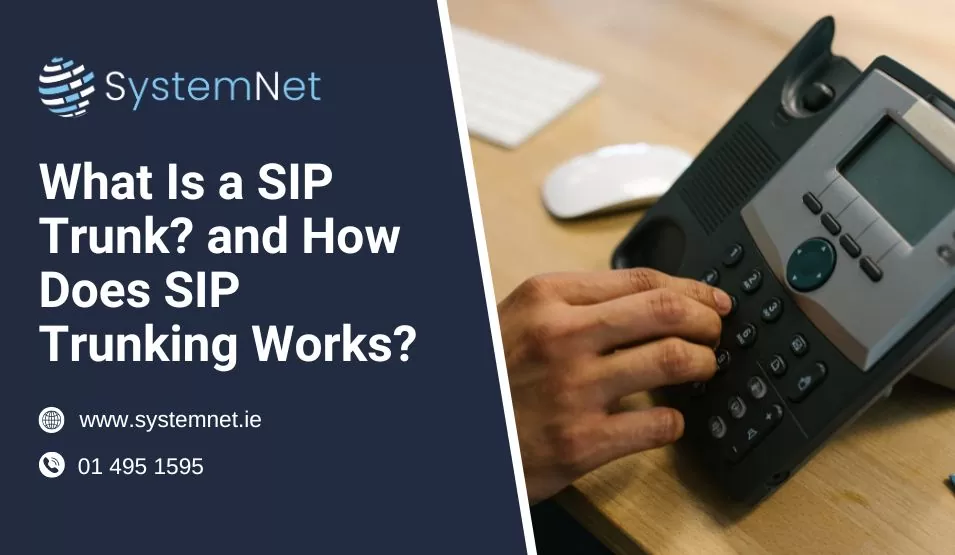SIP trunk, which stands for Session Initiation Protocol, is a method of connecting your business phone system to the public switched telephone network (PSTN) using Session Initiation Protocol (SIP) over the internet.
Essentially, SIP Trunking replaces traditional phone lines and PSTN trunking with internet telephony to deliver high-quality voice and video calls. It also helps in cost savings, and it seamlessly integrates even without needing physical phone lines.
What Is a SIP Trunk?
A SIP trunk is a virtual connection linking your private branch exchange (PBX) or VoIP phone system to the outside world using the Session Initiation Protocol. Rather than relying on analogue phone lines or primary rate interface (PRI) circuits, Session Initiation Protocol trunking uses your Internet Protocol (IP) network.
It’s provided by internet telephony service providers (ITSPs), who deliver voice and multimedia communication services through digital channels.
How SIP Trunking Works?
- Call initiation: You dial a number from your IP-based phone.
- SIP setup: Your PBX sends a SIP invite to the provider via the internet.
- Signal routing: The provider connects your call to the PSTN or VoIP endpoint.
- Media streaming: Voice or video travels using IP packets, not copper.
- Call termination: Once complete, a SIP message ends the session.
This entire process runs over a standard internet connection, allowing you to integrate voice, video, and messaging—all part of VoIP SIP trunking.
What Are The Benefits of SIP Trunking?
Cost Savings
Ditching analogue phone lines and PRI circuits cuts line rental and long-distance costs. With SystemNet’s SIP trunking service, for example, you get 2 concurrent channels from just €25/month—unlimited Ireland, UK and USA landline calls included.
Scalability and Flexibility
Need more lines? Simply upgrade your SIP trunk package; no hardware swaps needed. With SystemNet, you can ramp up from 2 to 16 channels instantly, matching growth seamlessly.
High-Quality Calls
With proper QoS settings and reliable infrastructure, call quality rivals traditional PSTN lines. You get high-quality, dependable voice and video with minimal jitter or dropout.
Integrated Multimedia Communication
SIP trunking isn’t just voice, but you can also add video conferencing and messaging. It centralises IP communications, simplifying your tech stack.
SIP Trunking vs VoIP: What’s the Difference?
- VoIP (Voice over Internet Protocol) is the umbrella technology of digital calling.
- SIP trunking service uses VoIP, but is specifically the connection between your PBX and the outside world.
- Think of VoIP as the method, and SIP trunking as your gateway.
You can use VoIP internally, but without SIP trunking, you’ll still need traditional lines to make public calls.
SIP Trunking vs PRI (Traditional Phone Lines)
| Feature | PRI / PSTN | SIP Trunking |
| Infrastructure | Copper-based analogue lines | Uses existing IP & internet networks |
| Scalability | Requires physical line changes | Easily add/remove channels online |
| Cost | High rental & call charges | Low line rental; cheaper international calls |
| Features & Integration | Limited, hardware-dependent | Supports voice, video, messaging, and QoS |
| Maintenance | On-site hardware upkeep | Cloud-managed, handled by the provider |
Switching frees you from the rigid primary rate interface systems and expensive analogue phone lines, letting you focus on IP communications.
Who Needs SIP Trunking?
SIP trunking suits businesses planning for growth, advanced features, or cost control:
- Call centres needing multiple concurrent lines
- Multi-site offices sharing numbers and resources
- Retail chains, hotels, and hospitality with frequent inbound/outbound calls
- Remote teams and hybrid setups are benefiting from internet-based telephony
- Enterprises wanting unified voice, video, and chat
- Any business ready to ditch the traditional phone line expense
What Do You Need to Set Up SIP Trunking?
- VoIP-compatible PBX or hosted phone system
- Stable high-speed internet with sufficient bandwidth
- Router/firewall with Quality of Service (QoS) configuration
- SIP trunk package that fits your call volume (SystemNet offers 2–16 channels)
That’s it, no heavy hardware, no messy cables, just plain efficiency.
Common Challenges and How to Avoid Them
Quality of Service (QoS) Problems
If voice packets get low priority, you may experience lag or dropout. Use QoS on routers to prioritise voice traffic.
Security Vulnerabilities
Unsecured SIP trunks risk toll fraud and eavesdropping. Harden your setup with encryption (TLS, SRTP), strong authentication, and firewalls.
Network Limitations
Insufficient bandwidth can choke calls. Run speed tests and invest in reliable internet or a dedicated link.
Configuration Errors
Mismatched codecs or improper SIP settings can cause dropped calls. Use best practices or seek expert setup assistance.
Conclusion
SIP trunking delivers streamlined, cost-effective, and expandable telephony that blows traditional lines out of the water. You’ll get high-quality voice and multimedia, easier upgrades, and strong integration for unified communication, all through your existing internet connection.
Whether you’re a growing startup, hotel, retail chain, or call centre, SIP trunking meets your needs more intelligently. With expert providers like SystemNet Communication, switching is simple, reliable, and future-ready.
Ready to upgrade your phone system and switch to smarter SIP trunking?
Talk to a SystemNet Expert today.
Frequently Asked Questions
1. How does SIP trunking save money?
By replacing expensive line rentals and reducing call charges, especially internationally, while offering pay‑as‑you‑grow pricing.
2. Can I use my current phone number?
Yes, SIP services allow you to port phone numbers so you don’t lose business contact continuity.
3. Do I need special hardware?
No, If your phone system already supports VoIP, you only need a reliable internet link and SIP service.
4. Is SIP trunking secure?
Yes, when properly configured. Use encryption, firewalls, and secure access to protect your communications.
5. Can SIP trunking handle video calls?
Absolutely, it supports voice, video, and other multimedia communication with the right codecs and bandwidth.

